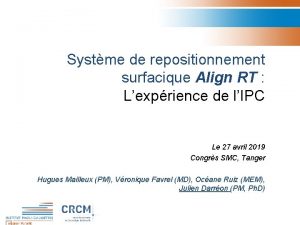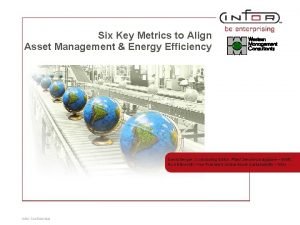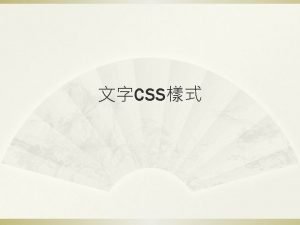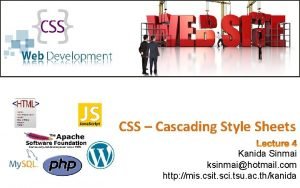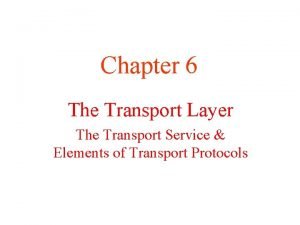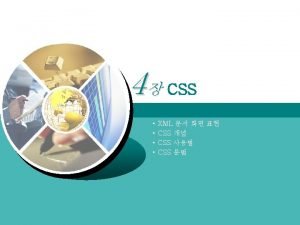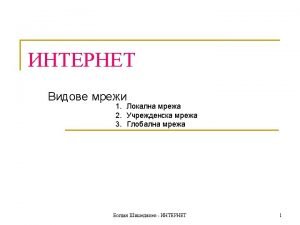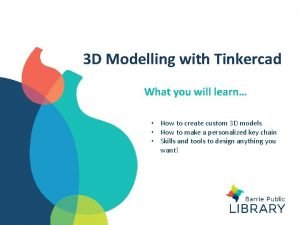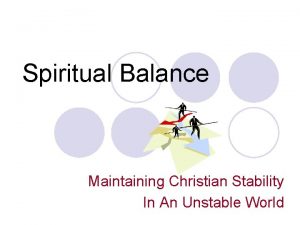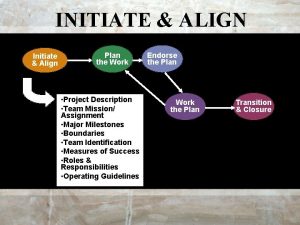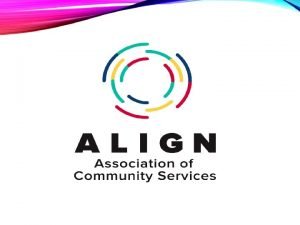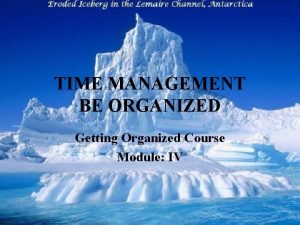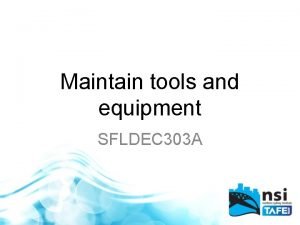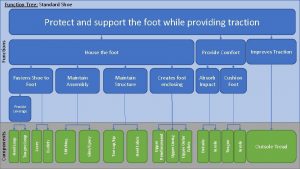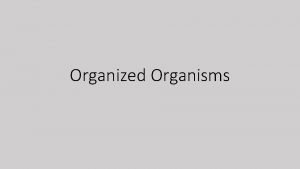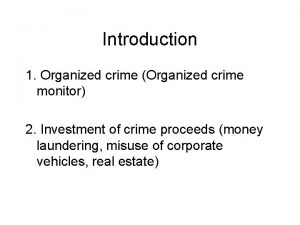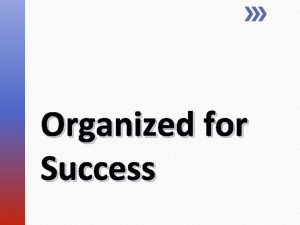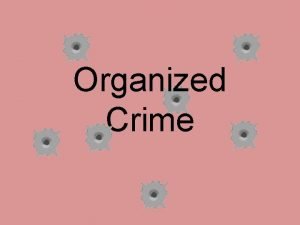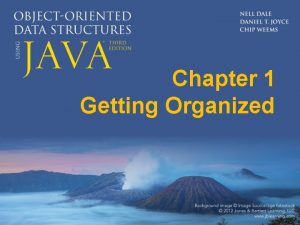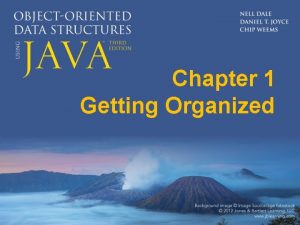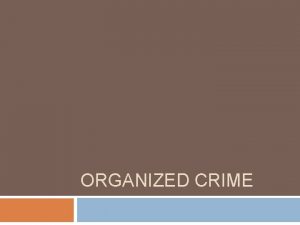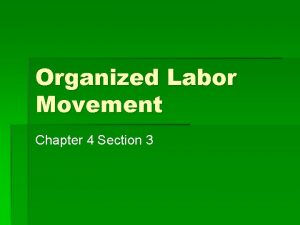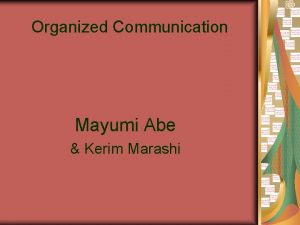Maintain an Organized Portfolio Align portfolio management practices




















- Slides: 20

Maintain an Organized Portfolio Align portfolio management practices with COBIT (APO 05: Manage Portfolio). Info-Tech Research Group, Inc. is a global leader in providing IT research and advice. Info-Tech’s products and services combine actionable insight and relevant advice with ready-to-use tools and templates that cover the full spectrum of IT concerns. © 1997 -2017 Info-Tech Research Group Inc. Info-Tech Research Group 1

ANALYST PERSPECTIVE Integrate your portfolio management practices into the broader realm of IT governance. Businesses put a lot of rigor into spending controls, down to lunch expenses and that new $30 mouse for your notebook. If we all put that level of rigor into our project portfolio, we would have the right number of projects and the right amount of time. We wouldn’t have to cancel many projects mid-stream and we wouldn’t commit to dates and deliverables that are unrealistic. Mostly, the leadership would feel like they are in control, guiding and steering as needed with a responsive organization pulling in the same direction. Integrate your portfolio management practice into the broader realm of IT governance. Make it practical so that you can be certain that it will always be followed, helping to drive project throughput, and never viewed as an inhibitor. Do this and your organization will be able to focus on delivery instead of the process itself. Barry Cousins, Senior Director, PMO Research Info-Tech Research Group 2

Our understanding of the problem This Research Is is Designed For: This Research Will Help You: üPortfolio Managers and PMO Directors who üBetter understand the current state of your need to establish more disciplined and mature portfolio management practices. üPMO Leaders and CIOs who want to standardize IT’s portfolio management practices and metrics in order to better maintain the project portfolio throughout its lifecycle. project portfolio. üEstablish a target mix of projects and programs for your portfolio. üAlign your portfolio management processes with broader IT frameworks (i. e. COBIT 5). This Research Will Also Assist: This Research Will Help Them: You: üCIOs looking for ways to improve the value of üBetter understand how the project portfolio can the IT project portfolio. üIT Steering Committee members looking for more rigorous portfolio governance standards. be aligned to strategic goals and financial and resource capacity. üGovern the portfolio by ensuring that those charged with managing it have a clear understanding of the criteria that should guide portfolio management decisions. Info-Tech Research Group 3

Executive summary Situation • As portfolio manager, you’re responsible for maintaining a portfolio of • projects and programs that represent the organization’s strategic and operational goals. You need processes and criteria to ensure the portfolio remains aligned with these goals and bound by financial and resourcing constraints. Complication • At present, the shape of the portfolio is largely determined by squeaky • wheels. It’s more like an unorganized heap of stakeholder demand rather than an organized collection of strategically valuable work. You lack a way forward for organizing the portfolio. The business has no agreed-upon standard for determining portfolio value and for judging those projects that are most worthy of inclusion. Info-Tech Insight Portfolio management is primarily about portfolios, not processes. In project portfolio management (PPM), it is common to get too fixated on processes and lose sight of the importance of the actual content of the portfolio. While processes are important, what is actually in the portfolio directly impacts the level of value creation achieved through it. A portfolio structured around well-defined value criteria, and driven by strong project selection practices, is the best way to keep the organization’s project activity aligned with its strategic goals. Resolution • Establish clear and consistent criteria for portfolio success. An organized portfolio depends upon a consistent set of • • criteria that can be used as a guiding star for portfolio value when it comes to project selection. Use this blueprint to help define the appropriate criteria for your portfolio and to help establish a process for managing the portfolio by this criteria. Equip yourself with the right portfolio organizers. Use the tools associated with this blueprint to help analyze the current state of your portfolio and identify how the organization more optimally spend its financial and human resource budgets to better align with and drive the organization’s strategic goals. Grow within a portfolio management framework, not into one. While industry frameworks like COBIT outline the necessary processes, they are often perceived as unrealistic or unattainable for organizations with low PPM maturity. This blueprint helps distill industry best practices into an actionable portfolio management program that can be scaled for use by organizations at any stage of PPM maturity. Info-Tech Research Group 4

Use clear standardized portfolio criteria and processes to organize your portfolio and improve portfolio management This image is absolutely terrifying for anyone in IT. BUT, this is exactly what a portfolio of programs and projects turns into if it is not carefully and continually organized and maintained. If this is not acceptable for $10 wires, why is it acceptable for projects and programs that can be worth hundreds of thousands (if not millions) of dollars? Just as the wiring in this image is possible with clear plans and rules, so too is an organized portfolio possible if a clear portfolio target mix is established and effective portfolio processes are in place. Portfolio management can be transformed from a random and overwhelming guessing game to an organized and manageable collection of projects that are contained within the organization’s actual capacity and aligned to the organization’s goals. Info-Tech Research Group 5

Choose between doing nothing to better maintain an organized portfolio or accepting significant project losses Monetary Losses Stop the leaks. Organizations LOSE an average of $109 MILLION for every $1 billion spent on projects. – PMI, High Cost of Low Performance, 2014 Opportunities Lost Don’t miss the boat. Higher Strategic Alignment % identifying as “highly agile”* 23% 5% Higher agility* Earning a net positive ROI on projects is difficult enough. Don’t find yourself fighting against rising losses that can be mitigated through improved portfolio management. *Note: In these quotes “agile” and “agility” refer to the ability “to respond successfully to change” and not the project management methodology. % reporting successful strategic initiatives Lower Strategic Alignment Lower agility* 69% 45% Agility Sacrificed w/o PPM -18 Success Sacrificed w/o PPM -24 Despite this, only 15 percent report high levels of organizational agility*, suggesting that organizations are not prepared to adapt to shifts in today’s complex market environment and shifts in consumer demands and expectations. – PMI, High Cost of Low Performance, 2014 Info-Tech Research Group 6

Investing in improved portfolio organization and management can yield net benefits Organizations identified as “portfolio management leaders” in a PMI survey are far more likely to report positively in the following areas: “Portfolio Management Leaders” “Others” ROI from strategic initiatives 30% 7% +23% Quality of decision making 32% 7% +25% Speed of implementation 35% 8% +27% Senior Management Satisfaction Reported Strategic agility Strategic adaptability 26% 38% 6% 6% Net Benefit for Portfolio Leaders +20% +32% Out of those organizations that tracked the benefits of maturing their PPM processes: 63% reported an ROI of 10% or more 50% ROI was reported by 10% Source: PM Solutions, “The State of Project Portfolio Management (PPM): 2013. ” (PMI, Implementing Project Portfolio, 2015, p. 10) Info-Tech Research Group 7

Sustain organization throughout the portfolio lifecycle All too often, discussions of portfolio management focus on processes, but PPM is ultimately about the portfolio. Processes are necessary to maintain the portfolio, but they are ultimately a means to an end. Represent Current Portfolio Mix Portfolio Criteria And Constraints Effective portfolio managers keep constantly focused on the portfolio itself and not merely adherence to workflows. Having clearly defined criteria and constraints ensures that the right kind of projects enter and leave the portfolio at the right time. Assess Alignment and Viability of Current Portfolio Mix Reprioritize Projects/ Programs Close and Terminate Projects/ Programs Accept New Projects/ Programs Assess Project/Program Benefits Achieved Info-Tech Research Group 8

Organize your portfolio with clearly defined goals and constraints Marketing Sales IT Production Marketing Sales IT Production Risk Constraints: Financial, Human Resourcing, Technology, Risk • These tell you: o What you have to work with. o How large the portfolio can be. Budget Technology Goals: Mission, Strategic, and Operational • These tell you: o What the outputs of the portfolio should be. o How much of the portfolio should be going to each division of the organization. Production IT Human Resources Strategic Goal 1 Strategic Goal 2 Strategic Goal 3 Info-Tech Research Group 9

Don’t grow into a framework, grow within one • All too often organizations perpetually delay implementing processes that are aligned with frameworks like COBIT or PMBOK. • Putting off alignment, however, only makes alignment more difficult later on. As your organization matures, more processes will be put into place. This means that there will be more processes to potentially align later on. • By starting early you can ensure that as the processes you have mature, they grow in a way that is aligned from the start rather than having to shift directions later on. Info-Tech Research Group 10

Align your PPM processes with industry standards This blueprint has been informed by COBIT 5 (APO 05), the PMI’s PMBOK (5 th Edition), and the U. S. Government’s ITIM framework. Other relevant frameworks and guides are also listed below. Information Systems Audit and Control Association (ISACA) • COBIT 5 • Enterprise Value: Governance of IT Investments: VAL IT Framework Project Management Institute (PMI): • Project Management Body of Knowledge – 5 th Edition. (PMBOK) • Standard for Portfolio Management – Third Ed. (PMI) Government of the United States of America • Information Technology Investment Management (ITIM) o Free Online: Designed for federal public sector, but applicable beyond this. • Assessing Risks and Returns: A Guide for Evaluating Federal Agencies' IT Investment Decision-making (GAO 1997) International Organization for Standardization (ISO) • ISO 21504: 2015 Project, Programme and Portfolio Management – Guidance on Portfolio Management Info-Tech Research Group 11

Info-Tech uses COBIT to help situate portfolio management within a large IT governance framework Why COBIT? • • Info-Tech is committed to producing projects and advice that are COBIT aligned. This helps ensure that our own research uses consistent terms and concepts across the different research areas. COBIT’s PPM framework is both comprehensive yet also compact. It breaks down the various aspects of PPM into six core areas of focus. COBIT covers all areas of IT governance and management. For organizations that have aligned other areas of IT to COBIT, it will be easier to integrate the PPM roles, accountabilities, responsibilities, processes, and activities into the broader IT governance and management structures. Low maturity organizations can implement basic processes yet still be aligned to COBIT (at least in terms of the spirit and direction of COBIT). (COBIT 5, 24) Info-Tech Research Group 12

Take an actionable approach to COBIT APO 05 This blueprint provides a tactical approach to APO 05, helping organizations of all sizes incorporate COBIT best practices into their portfolio management practices. Within COBIT, portfolio management is broken down into six distinct yet interrelated sub-processes. The portfolio criteria and metrics established in the first sub-process are used in each following sub-process. This blueprint will help you define these criteria and metrics for your portfolio. It will then help to build a set of processes around your criteria to ensure they guide portfolio decisions and help the organize realize value from its project activity. External Inputs Source of Input Strategic and operational goals Executive Annual budget CFO Resource capacity HR External Outputs Portfolio reports and/or dashboard Project and program benefits report Info-Tech Research Group 13

Improved portfolio management through current-state analysis, framework adoption, and organizational change management CASE STUDY Industry Source Healthcare PMI Case Study: Ameri. Health Mercy, 2014. Challenge A new director was hired to take over a three-year-old PMO. During those three years the PMO had implemented standard project management processes and artifacts; however, based on previous experience the new director believed that also improving portfolio management could help improve the strategic alignment of the portfolio and the overall success of the organization. Solution The new director started by carrying out a thorough current-state assessment of project and portfolio management at the organization. The diagnostic and analysis confirmed that there were gaps in portfolio management processes and highlighted project prioritization as a particular area in need of improvement. Results Based on the current-state analysis, the new director was able to create a prioritized high-level (quarter by quarter) roadmap of portfolio management improvements. They started by identifying clear prioritization criteria and implementing a prioritization process. They also clarified portfolio management roles and responsibilities. Implementation challenges arose, but adopting organizational change management practices allowed them to adapt and learn from them. Ultimately, they were able to achieve greater strategic alignment of the portfolio and showed this to the organization. EXPERIENCE: Assess the effectiveness of rules and criteria in practical experience. Record revised rules, roles, relationships and criteria. Record revised rules, roles, relationships, and criteria. FRAMEWORK: Use a framework to organize and harmonize rules and criteria. Info-Tech Research Group 14

Follow Info-Tech’s blueprint to maintain an organized portfolio of projects and programs Assess the current state of the portfolio and PPM processes 1. Assess the current state of the portfolio mix Portfolio Mix Assessment Enhance portfolio organization through improved PPM criteria and processes 1. Establish the target investment mix (APO 05. 01) 2. Determine the availability and sources of funds (APO 05. 02) Implement improved portfolio management practices 1. Plan organizational changes necessary to improve portfolio management practices Change Impact Analysis 2. Assess the current state of PPM processes 3. Evaluate and select projects or programs to fund (APO 05. 03) 4. Monitor portfolio performance (APO 05. 04) 5. Maintain the portfolio (APO 05. 05) 6. Manage benefits achievement (APO 05. 06) Portfolio Management Process Assessment Portfolio Management SOP Info-Tech Research Group 15

Info-Tech’s approach to portfolio management is informed by industry best practices and rooted in practical research Relative to project management research and frameworks, the literature available on portfolio management is in its early stages of development; however, industry best practices can still provide insight – so long as they’re consumed with a view of the day-to-day reality of IT departments in the present. Info-Tech consulted PMI and COBIT 5 frameworks where appropriate. Our understanding of the role of project portfolio management is generally aligned with these frameworks. The process outlined for implementing portfolio management processes is directly based upon the COBIT framework, especially APO 05. In fact, Phase 2 provides advice and activities to help organizations implement the six sub-processes for APO 05 and uses the title of each sub-process for the steps in that phase. PMBOK is the leading project management industry framework, providing project management best practices and process guidelines. COBIT 5 is the leading framework for the governance and management of enterprise IT. In addition to industry-leading frameworks, our best-practice approach is enhanced by the insights and guidance from our analysts, industry experts, and clients. 33, 000+ Our peer network of over 33, 000 happy clients proves the effectiveness of our research. Our team conducts primary and secondary research to ensure that our approach is enhanced by best practices. Info-Tech Research Group 16

Use these icons to help direct you as you navigate this research Use these icons to help guide you through each step of the blueprint and direct you to content related to the recommended activities. This icon denotes a slide where a supporting Info-Tech tool or template will help you perform the activity or step associated with the slide. Refer to the supporting tool or template to get the best results and proceed to the next step of the project. This icon denotes a slide with an associated activity. The activity can be performed either as part of your project or with the support of Info-Tech team members, who will come onsite to facilitate a workshop for your organization. Info-Tech Research Group 17

Info-Tech offers various levels of support to best suit your needs DIY Toolkit “Our team has already made this critical project a priority, and we have the time and capability, but some guidance along the way would be helpful. ” Guided Implementation Workshop Consulting “Our team knows that we need to fix a process, but we need assistance to determine where to focus. Some check-ins along the way would help keep us on track. ” “We need to hit the ground running and get this project kicked off immediately. Our team has the ability to take this over once we get a framework and strategy in place. ” “Our team does not have the time or the knowledge to take this project on. We need assistance through the entirety of this project. ” Diagnostics and consistent frameworks used throughout all four options Info-Tech Research Group 18

Maintain an Organized Portfolio – project overview 1. Assess Current State 2. Enhance Portfolio Organization 1. 1 Assess current portfolio mix 2. 1 Establish the target mix (APO 05. 01) 1. 2 Assess current portfolio management practices 2. 2 Determine sources of funding and resourcing (APO 05. 02) 3. Plan to Implement Changes 3. 1 Prepare the organization for portfolio management change 2. 3 Select projects and programs (APO 05. 03) 2. 4 Monitor performance (APO 05. 04) 2. 5 Maintain through closure, termination, and reprioritization (APO 05. 05) Best-Practice Toolkit 2. 6 Track benefits (APO 05. 06) Assess portfolio mix. Assess portfolio management practices. Integrating standard portfolio criteria across all portfolio management subprocesses. Create a stakeholder engagement plan. Initiate the projects and engagement. Review the SOP. Guided Implementations Module 1: Assess the current state of your portfolio and your portfolio management practices Module 2: Enhance portfolio organization through improved portfolio criteria and improved workflows Module 3: Ensure sustainable long-term adoption of proposed changes through stakeholder engagement Phase 1 Outcome: • Current-state assessment • PPM improvement roadmap Phase 2 Outcome: • Improved PPM processes based upon clearly defined and standard criteria • Portfolio Management SOP Phase 3 Outcome: • Change impact analysis • Stakeholder engagement plan Onsite Workshop Info-Tech Research Group 19

Workshop overview Deliverables Activities Contact your account representative or email Workshops@Info. Tech. com for more information. Workshop Day 1 Workshop Day 2 Workshop Day 3 Workshop Day 4 Workshop Day 5 Assess Portfolio Mix Current State Assess Portfolio Process Current State Define Portfolio Target Mix, Criteria, and Roadmap Design Improved Portfolio Sub-Processes Change Impact Analysis and Stakeholder Engagement Plan 1. 1 (Pre-work: Prepare a complete project list. ) 1. 2 Define existing portfolio categories, criteria, and targets. 1. 3 Analyze the current portfolio mix. 1. 4 Identify areas of concern with current portfolio mix. 2. 1 Review the six COBIT sub-processes for portfolio management (APO 05. 01 -06). 2. 2 Assess the degree to which these subprocesses have been currently achieved at the organization. 2. 3 Assess the degree to which portfolio supporting IT governance and management processes exist. 2. 4 Perform a gap analysis. 1. Analysis of the current portfolio mix 1. Assessment of COBIT alignment and gap analysis 3. 1 Identify determinants of the portfolio mix, criteria, and constraints. 3. 2 Define the target mix, portfolio criteria, and portfolio metrics. 3. 3 Identify sources of funding and resourcing. 3. 4 Review and record the portfolio criteria based upon the goals and constraints. 3. 5 Create a PPM improvement roadmap. 1. Portfolio criteria 2. Portfolio metrics for intake, monitoring, closure, termination, reprioritization, and benefits tracking 3. Portfolio management improvement roadmap 4. 1 Ensure that the metrics used for each sub-process are based upon the standard portfolio criteria. 4. 2 Establish the roles, accountabilities, and responsibilities for each sub-process needing improvement. 4. 3 Outline the workflow for each sub-process needing improvement. 1. A RACI chart for each sub-process 2. A workflow for each sub -process 5. 1 Conduct a change impact analysis. 5. 2 Create a stakeholder engagement plan. 1. Portfolio management SOP (combining the outputs of days 3 and 4) 2. Change impact analysis 3. Stakeholder engagement plan Info-Tech Research Group 20
 Predictive analytics staffing
Predictive analytics staffing Align rt
Align rt Complete the statement accenture delivery suite
Complete the statement accenture delivery suite Align assets shutdown
Align assets shutdown Imgt domain gap align
Imgt domain gap align Text decoration blink
Text decoration blink Image url to text
Image url to text Vertical-align
Vertical-align Text align css
Text align css Cascading order
Cascading order Vertical align
Vertical align Upward multiplexing and downward multiplexing
Upward multiplexing and downward multiplexing Vertical align
Vertical align Jointly learning to align and translate
Jointly learning to align and translate Taghtml?title=
Taghtml?title= Realign study
Realign study Secrethdd
Secrethdd Tinkercad workplane size
Tinkercad workplane size Types of portfolio
Types of portfolio How to maintain spiritual stability
How to maintain spiritual stability How to maintain friendships
How to maintain friendships

